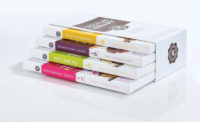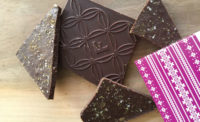Bob Leavitt loves the looks he gets when people try one of his “internationally inspired” chocolate bars.
Leavitt, who founded Vivra Chocolate in 1984 with his wife, Paige, creates products with adventurous flavor combinations, pairing sweet with heat and floral with citrus. He pointed to the Curry Cashew Bar, which blends warm, aromatic spices and toasted cashews with milk chocolate.
“Sometimes when we are out sampling this new flavor of ours, some people come up to me and ask, ‘Curry with chocolate?’ They give me a raised eyebrow and then try it,” Leavitt says. “You should see the look of surprised delight on their face.”
Vivra, based in Boston, Mass., also offers the Milk Chocolate Thai Satay Bar, with peanuts, coconut, sesame seeds and Thai Bird’s Eye chilis, and the Dark Chocolate English Garden Bar with sweet basil, thyme, Meyer lemon and French candied violets — a far cry from the classic combinations that have pleased consumers for decades.
“We know that innovation in flavors opens up people’s eyes to the endless possibilities that the world has to offer,” Leavitt says.
And that’s just what the U.S. chocolate market needs, data show. Overall chocolate dollar sales rose by 1.48 percent over the 52 weeks ending June 11, according to IRI, a Chicago-based research firm. Unit sales remained virtually flat (0.52 percent) at 6.6 billion.
Dollar sales for the 3.5-ounce-and-smaller category pulled in $4.2 billion over the last year, up 2.77 percent from last year. Unit sales grew by 1.22 percent to reach 3.29 million.
Not shockingly, Hershey and Mars dominated the Top 10 brands monitored by IRI in the category. Reese’s led the pack with just over $600 million in sales over the last 52 weeks. M&M’s followed with $489 million, while Snickers took third with $438 million. Hershey’s flagship brand and Kit Kat rounded out the Top 5.
Though smaller brands have more difficulty winning shelf space and consumer purchases than well-established, multinational brands, they often have more flexibility and can adapt quicker to trends and consumer needs, says Packaged Facts’ 11th edition of “Chocolate Candy Market in the U.S.”
“The industry is controlled by mass market players such as Hershey and Mars, and the overall health of the industry can largely be measured by how those companies’ brands are performing,” the report reads. “But much of the industry’s innovation still comes from smaller operators, local and regional chocolatiers who introduce new ingredients, flavors and textures that consumers are eager to try.”
Andrew Whisler, executive v.p. of marketing and business development for Hammond’s Brands, agreed.
“Smaller manufacturers have much more ability to get really creative with their flavor profiles compared to bigger guys who seem to use a lot of combinations of the same flavors,” he said.
Earlier this year, Hammond’s unveiled three flavors playing off consumers’ favorite snacks. The Cinnamon Churro bar combines cinnamon and a vanilla glaze filling with milk chocolate, while the Fortune Cookie bar has fortune cookie pieces in dark chocolate. The wrapper also features one of 24 unique fortunes, as well as lucky numbers and a “learn to speak Chinese” word.
The Midnight Snack bar, meanwhile, includes pretzels, cookies, brittle, marshmallow and cereal in a milk chocolate base.
“It sounds busy, but it actually balances out amazingly with the perfect combination of sweet, salty and crunch,” Whisler said.
And with more research illustrating the health benefits of flavanols — compounds found naturally in cacao — more manufacturers are introducing products with cacao percentages that are 80 or higher. Taza Chocolate, based in Somerville, Mass., has introduced a handful of 2.5-oz., stone-ground chocolate bars with 80 percent cacao, as well as the Wicked Dark bar, which has a whopping 95 percent cacao.
“What was once a simple, indulgent treat has taken on more roles as eating habits change,” says Stephanie Larason, Taza marketing and communications manager. “Many bars play the role of sweet snack, but since the health benefits of cacao have become so well known, chocolate bars, especially dark varieties, now combine indulgence with a functional role for the consumer.”
And if manufacturers mix flavanol-rich chocolate with fruit, they have a winning, healthful combination says Peter Dehasque, group ceo for Taura Natural Ingredients. He said using fruit gives manufacturers a way to add flavor and reduce calorie content.
“We’re seeing an explosion of new flavor combinations,” Dehasque said. “Ten percent of all chocolate launches now have a fruit flavor, and now consumers can choose from a huge list of combinations — chocolate with passion fruit, chocolate with pomegranate, chocolate with lychee.”
Ralph Chauvin, ceo of NibMor, Inc., also noted chocolate’s ability to serve as a permissible indulgence, adding that certifications for organic ingredients and sustainable cocoa help to “legitimize” products in the eyes of discerning and conscious consumers.
However, Chauvin said balancing price with cocoa percentages and certifications is important, since the price of chocolate bars is part of what makes them appealing to consumers in the first place.
“The pricing is key,” he says. “If you start selling these higher-end chocolates at a much higher price point than your everyday chocolate, at this point in time, I don’t feel as if you’re going to attract many more consumers to those items.”
That’s why NibMor offers its organic-, non-GMO- and Rainforest Alliance-certified line alongside bars that are all-natural and don’t carry the price of the certifications.
“We’re trying to offer better-for-you chocolate without breaking the bank,” Chauvin says.
But no matter what’s paired with it or how it’s sourced and produced, chocolate has one quality that’s certain, Leavitt says.
“Chocolate is one of the true joys of life,” he says.





